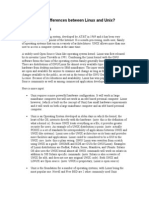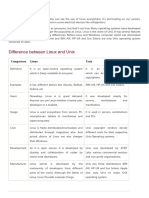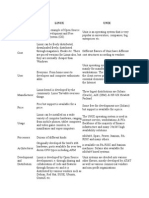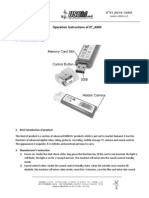0% found this document useful (0 votes)
23 views8 pagesDifference Between Linux and UNIX
The document compares Linux and UNIX, highlighting that UNIX is a proprietary, multi-user operating system developed in the late 1960s, while Linux is a free, open-source alternative created in 1991. Key differences include licensing, development models, hardware compatibility, and user bases, with UNIX being more common in enterprise environments and Linux widely used in various applications including servers and mobile devices. Both operating systems have their advantages and disadvantages, and the choice between them depends on specific security needs, costs, and application requirements.
Uploaded by
arindamghorui03Copyright
© © All Rights Reserved
We take content rights seriously. If you suspect this is your content, claim it here.
Available Formats
Download as PPTX, PDF, TXT or read online on Scribd
0% found this document useful (0 votes)
23 views8 pagesDifference Between Linux and UNIX
The document compares Linux and UNIX, highlighting that UNIX is a proprietary, multi-user operating system developed in the late 1960s, while Linux is a free, open-source alternative created in 1991. Key differences include licensing, development models, hardware compatibility, and user bases, with UNIX being more common in enterprise environments and Linux widely used in various applications including servers and mobile devices. Both operating systems have their advantages and disadvantages, and the choice between them depends on specific security needs, costs, and application requirements.
Uploaded by
arindamghorui03Copyright
© © All Rights Reserved
We take content rights seriously. If you suspect this is your content, claim it here.
Available Formats
Download as PPTX, PDF, TXT or read online on Scribd
/ 8






















































































